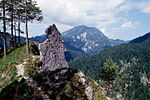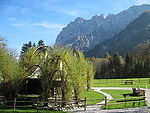National parks of Austria

valleys.[2]
Development

First plans for the protection of the Hohe Tauern mountain range were evolved by
Tyrol and Carinthia signed the Heiligenblut Agreement, followed by similar initiatives in Lower and Upper Austria
.
The establishment of each national park took several years; as conflicts of use and the question of funding had to be resolved. The parks are managed by contracts between one or more of the
federal states and the Federal Government,[2] with the financing shared equally between the Austrian government and the respective province.[3] The national park administrations offer more than 300 green jobs. The park centres provide the public with educational services on ecology and environmental protection, information and leisure activities.[2] With about 400,000 visitors a year, they play an important role in Austrian tourism
.
National Parks
Of the seven national parks, four are protecting Austrian
Hohe Tauern; at 1,856 square kilometres (459,000 acres), it is also the largest national park in Central Europe. The Neusiedler See–Seewinkel and Thayatal national parks stretch across the border with Hungary and the Czech Republic
respectively.
| Name | Photo | Location | Date established | Area | Description |
|---|---|---|---|---|---|
Hohe Tauern
|

|
1981 (Carinthia) 1984 (Salzburg) 1992 (Tyrol) |
1,856 square kilometres (458,627.6 acres) | Covering large parts of the forests. | |
| Neusiedler See–Seewinkel | 
|
Burgenland 47°49′04″N 16°44′55″E / 47.817778°N 16.748611°E |
1993 | 97 square kilometres (23,969.2 acres) | Covering Lake Neusiedl, its shoreline and lakeside locations. Together with the adjacent Hungarian Fertő-Hanság National Park it forms the Fertö / Neusiedlersee Cultural Landscape, a UNESCO World Heritage Site since 2001. |
| Danube-Auen | 
|
Lower Austria, Vienna 48°11′00″N 16°43′00″E / 48.183333°N 16.716667°E |
1996 | 93 square kilometres (22,980.8 acres) | Stretching along the Danube from the City of Vienna (Lobau) to the mouth of the March (Morava) river near the border with Slovakia and the Dunajské luhy Protected Landscape Area; both are wetlands of international importance according to the Ramsar Convention. With a length of 38 kilometres (24 mi), the national park covers one of the largest untouched floodplains in Central Europe, accessible by the EuroVelo 6 long-distance cycling route. |
| Kalkalpen | 
|
Upper Austria 47°47′24″N 14°22′25″E / 47.79°N 14.373611°E |
1997 | 208 square kilometres (51,397.9 acres) | Covering the Sengsengebirge and Reichraminger Hintergebirge ranges of the Upper Austrian Prealps. |
| Thayatal | 
|
Lower Austria 48°51′N 15°54′E / 48.85°N 15.9°E |
2000 | 13 square kilometres (3,212.4 acres) | Centered around a meander cutoff of the Thaya river, on the border with the Czech Republic and the adjacent Podyjí National Park. The steep gneiss slopes along the river form one of Austria's most picturesque water gaps. |
| Gesäuse | 
|
Styria 47°35′32″N 14°38′56″E / 47.592222°N 14.648889°E |
2002 | 111 square kilometres (27,428.7 acres) | Covering the Gesäuse range of the northeastern Ennstal Alps in Upper Styria with the water gap of the Enns river. |
All of Austria's national parks meet IUCN Category II standards. The Nock Mountains (formerly also one of Austria's National Parks) had been classified as a Protected Landscape (Category V), and in 2012 it was converted into the core zone of a UNESCO Biosphere Reserve.[4]
See also
References
- ^ "Nationalparks Austria - nationalparksaustria.at | EN". www.nationalparksaustria.at. Retrieved 2020-09-28.
- ^ ISBN 92-64-01888-3.
- ^ Nationalparks Austria. "Welcome to Austria's National Parks". Archived from the original (PDF) on 2012-03-24. Retrieved 2011-05-21.
- ^ "Biosphärenparks Österreich - Model region". www.biosphaerenparks.at. Retrieved 2020-09-28.
External links
- https://www.nationalparksaustria.at/en/ Official site.
